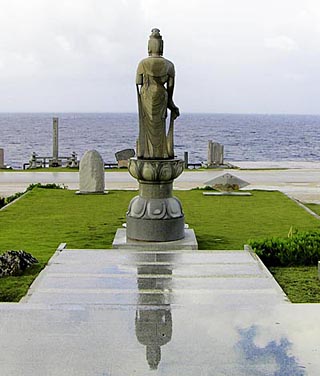If you could travel through time to the beach on Okinawa in 1945, how would it change your perceptions of World War II? By expanding the ways we learn and communicate about the war's history, historians Alice Yang and Alan Christy hope to also expand our understanding and awareness.
Through UCSC's Center for the Study of Pacific War Memories, the two historians are building an international online community focused on the history of WWII in the Pacific. The project recently received funding from the National Endowment for the Humanities.
The center grew out of Yang and Christy's enormously popular UCSC undergraduate course on WWII history. A major issue for the course was the lack of historical source materials in English.
"We wanted to give our students greater access to information," says Christy, "without teaching all of them Japanese in one quarter."
They also kept wishing their students could actually visit key WWII sites. The southern tip of Okinawa island, site of the war's last land battle, is one such place.
"We can’t load students on a plane to Okinawa," notes Christy, "but maybe we can bring Okinawa to them in a way that’s experiential."
The center's interactive web site, "Eternal Flames: Living Memories of the Pacific War," will link researchers, students, and those who experienced WWII to shape a multinational, multilingual view of the conflict. "Eternal Flames" will integrate the features of a web-based digital archive, an interactive "wiki," and an online forum. It will provide unprecedented large-scale linking and translation of a wide range of historical documents.
Yang and Christy have also teamed up with Pat Mantey, Jack Baskin Professor of Engineering, to facilitate experiential learning and international communication. Using Mantey's "hyperwall," a large array of 40 flat-panel video screens, they will virtually transport UCSC viewers to Okinawa’s massive memorial complex, the Cornerstone of Peace.
Using historical photos, maps, and other materials, the hyperwall will also become a time machine, enabling viewers to tour the complex as it is today, then peel back "layers" to experience the same site through history. Future plans include installing similar hyperwalls in Okinawa and elsewhere to support teleconferencing and virtual networking.
Yang emphasizes that the project is more than a research and teaching tool: "Ultimately, we’re connecting people to people, building bridges between historians and the public, and getting students involved in collaborative projects like oral histories."
Yang’s research explores human rights violations related to the war, including the internment of Japanese Americans, military sexual slavery, POW treatment, and the Nanjing massacre. These issues remain very much alive today, and her hope is that the site will bridge cultural boundaries to shed light on these and other ongoing debates.

